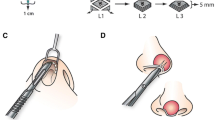Abstract
Purpose
Capsular contracture is a rare but serious complication of silicone implant-based augmentation rhinoplasty. When severe, the contracture can affect all layers of the nose, causing significant scarring and disfigurement. There is currently no standardized method of evaluating contracted noses and a paucity of literature on the treatment of severe contracture. Therefore, this study aimed to establish a comprehensive grading system and treatment approach for patients with nasal contracture secondary to silicone implant-based rhinoplasty.
Methods
We conducted a retrospective analysis on patients who presented with nasal contracture from 2012 to 2021. All preoperative photographs were evaluated by two plastic surgeons, twice at 1-month intervals. The proposed grading system comprised: normal (grade I), mild contracture with detectable implant (grade II), moderate contracture with skin thinning (grade III), severe contracture with short nose deformity (grade IV), and destructive contracture with scarring of the dorsal skin (grade Va), or columella deficiency (grade Vb). Inter- and intraobserver agreement was assessed using the kappa value to determine the reliability of the system.
Results
Based on 87 patients, interobserver agreement was substantial for both evaluation time points (k = 0.701 and 0.723). Intraobserver agreement was excellent for evaluator 1 (k = 0.822) and substantial for evaluator 2 (k = 0.699).
Conclusions
Using this grading system, we propose a graduated treatment algorithm for contracted noses. Most notable is our use of radial forearm free or forehead flaps to reconstruct the columella in grade Vb patients. By combining reconstructive and aesthetic principles, this treatment approach provides an effective and elegant solution for the management of the severely contracted nose.
Level of Evidence IV
This journal requires that authors assign a level of evidence to each article. For a full description of these Evidence-Based Medicine ratings, please refer to the Table of Contents or the online Instructions to Authors www.springer.com/00266.






Similar content being viewed by others
References
Lam SM (2009) Asian rhinoplasty. Semin Plast Surg 23:215–222
Zeng Y, Wu W, Yu H, Yang J, Chen G (2002) Silicone implant in augmentation rhinoplasty. Ann Plast Surg 49:495–499
Kim IS (2018) Augmentation rhinoplasty using silicone implants. Facial Plast Surg Clin N Am 26:285–293
Wu C, Yang S, Zheng G, Huang C, Tu J (2022) A systematic review and meta-analysis of the efficacy and complication rates of augmentation rhinoplasty with autologous cartilage and silicone prosthesis. Ann Palliat Med 11:993–1000
Sunwoo W, Jung H, Kim DW, Jin HR (2017) Immunohistochemical analysis of capsular contracture in silicone implant rhinoplasty. JAMA Facial Plast Surg 19:436–437
Jirawatnotai S, Mahachitsattaya B (2019) Analysis of subclinical infections and biofilm formation in cases of capsular contracture after silicone augmentation rhinoplasty: prevalence and microbiological study. Arch Plast Surg 46:160–166
Oh YH, Seo JW, Oh SJ, Oum IT, Kim G, Kim J, Kim SY, Shin SW, Park D, Kim KK (2016) Correction of severely contracted nose. Plast Reconstr Surg 138:571–582
Kim YK, Shin S, Kang NH, Kim JH (2017) Contracted nose after silicone implantation: a new classification system and treatment algorithm. Arch Plast Surg 44:59–64
Steiert AE, Boyce M, Sorg H (2013) Capsular contracture by silicone breast implants: possible causes, biocompatibility, and prophylactic strategies. Med Devices (Auckl) 6:211–218
Spear SL, Baker JL Jr. (1995) Classification of capsular contracture after prosthetic breast reconstruction. Plast Reconstr Surg 96:1119–1123 (discussion 1124)
Chang G-U, Jung D-H (2017) A new classification system of nasal contractures. J Cosmet Med 1:106–111
Wang X, Zeng W, Sun Y, Xiong X, Meng X, Li W, Yi Z, Fang B, Tian Y, Qiao Z, Deng Y, Zhao H (2023) New classification system of contracted nose and its treatment algorithm. J Plast Reconstr Aesthet Surg 85:414–422
Brodland DG (2005) Paramedian forehead flap reconstruction for nasal defects. Dermatol Surg 31:1046–1052
Shokri T, Kadakia S, Saman M, Habal MB, Kohlert S, Sokoya M, Ducic Y, Wood-Smith D (2019) The paramedian forehead flap for nasal reconstruction: from antiquity to present. J Craniofac Surg 30:330–333
Yen CI, Kao HK, Chang CS, Huang CJ, Chen HC, Yang SY, Chang SY, Yang JY, Chuang SS, Hsiao YC (2023) Simultaneous free flap and forehead flap for nasal reconstruction. Microsurgery 43:470–475
Moore AM, Montgomery J, McMahon J, Sheikh S (2014) Osteocutaneous radial forearm free flap in subtotal nasal reconstruction. BMJ Case Rep 2014:bcr2014207147
Funding
The authors have no commercial associations or financial disclosures to declare.
Author information
Authors and Affiliations
Corresponding author
Additional information
Publisher's Note
Springer Nature remains neutral with regard to jurisdictional claims in published maps and institutional affiliations.
Rights and permissions
Springer Nature or its licensor (e.g. a society or other partner) holds exclusive rights to this article under a publishing agreement with the author(s) or other rightsholder(s); author self-archiving of the accepted manuscript version of this article is solely governed by the terms of such publishing agreement and applicable law.
About this article
Cite this article
Hong, D.W., Oh, J.H., Wang, J. et al. A Grading System-Guided Approach to the Severely Contracted Nose. Aesth Plast Surg (2024). https://doi.org/10.1007/s00266-024-03957-8
Received:
Accepted:
Published:
DOI: https://doi.org/10.1007/s00266-024-03957-8




